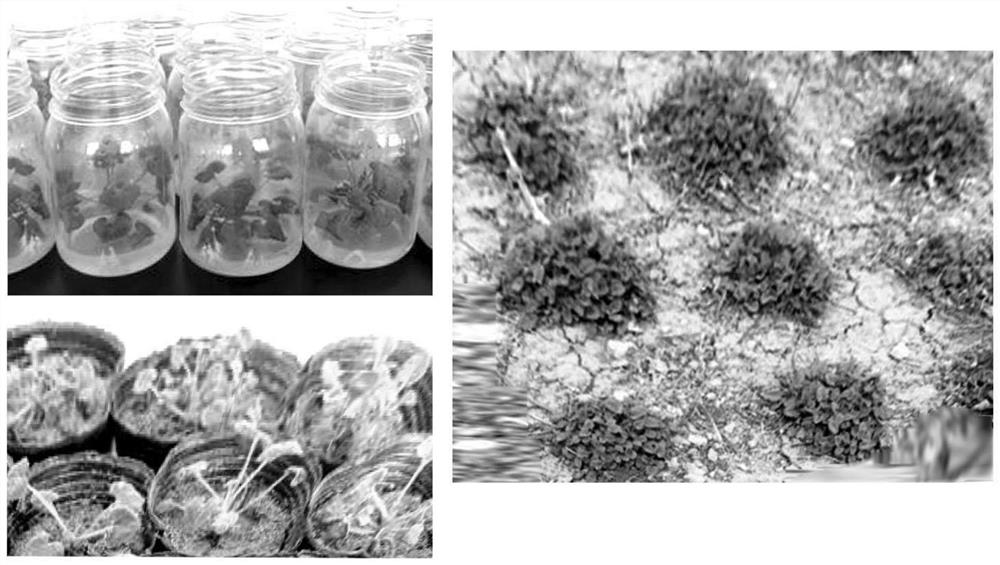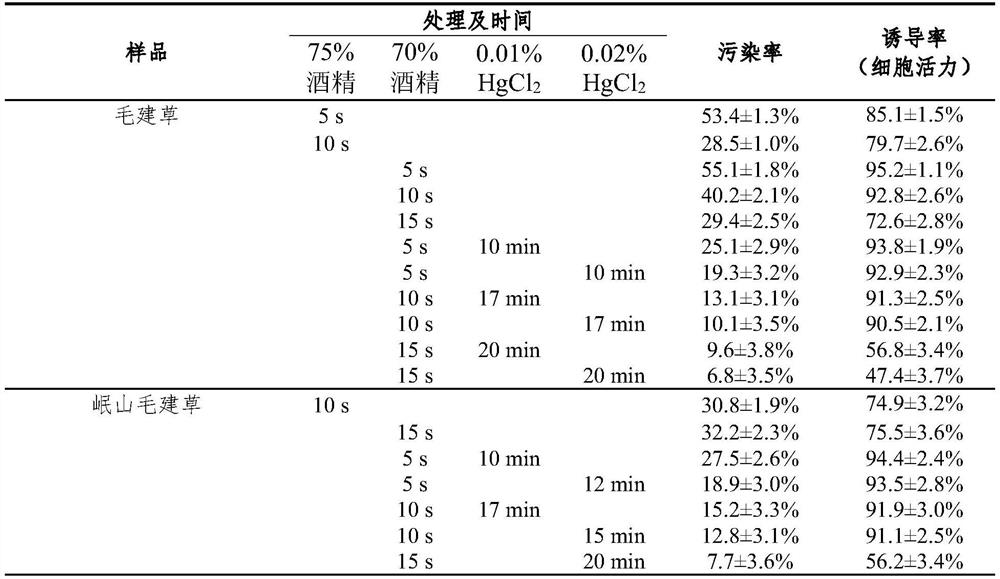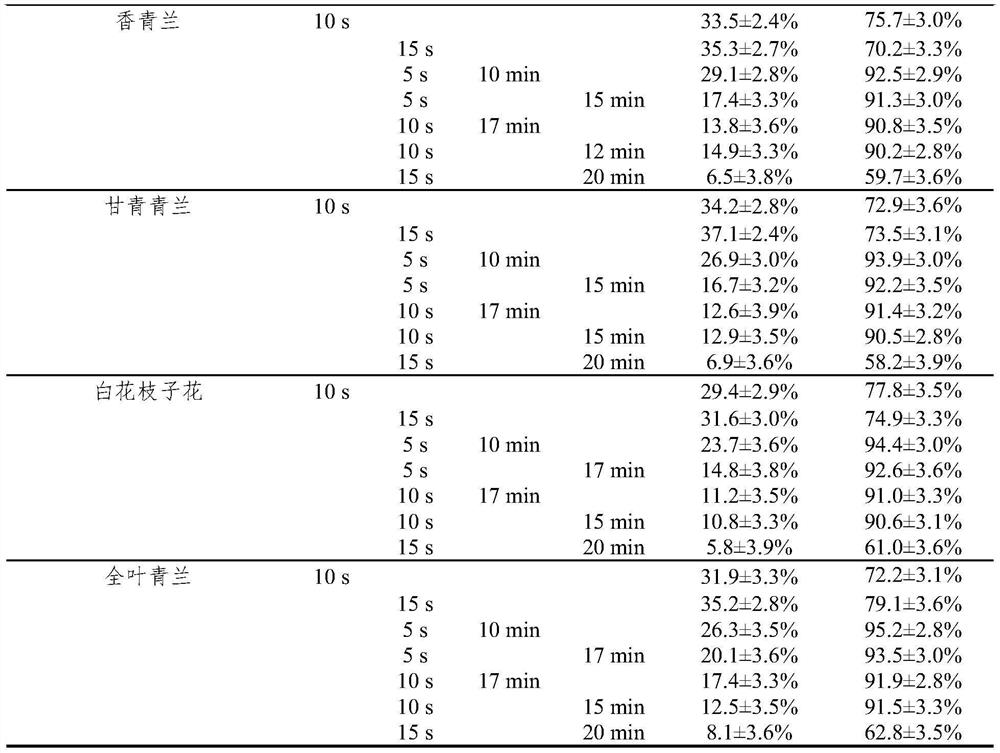A Tissue Culture Rapid Propagation Method of Orchid and Its Application
A tissue culture fast propagation and plant technology, which is applied to the field of tissue culture and fast propagation of Orchid plants, can solve the problems of browning of tissue materials, difficult to collect, small seeds, etc., and achieves the promotion of rooting of sprouts and the formation of high-efficiency inducing shoots. and growth effects
- Summary
- Abstract
- Description
- Claims
- Application Information
AI Technical Summary
Problems solved by technology
Method used
Image
Examples
Embodiment 1
[0038] A method for tissue culture rapid propagation of blue orchids, comprising the following steps:
[0039] S1. Acquisition of sterile explants: take the whole plant of Maojiancao, and under sterile conditions, use alcohol with a mass concentration of 70% to quickly sterilize it for 5 seconds, and then use HgCl with a mass concentration of 0.01% 2 The solution was sterilized for 10 minutes, and finally rinsed with sterile water for 5 to 6 times to obtain sterile explants (contamination rate 25.1%);
[0040] S2. Induction culture: Take 0.5 cm of sterile explants, inoculate them in the induction medium, and cultivate them for 7 days to obtain callus tissue (the healing rate is 86.85%); wherein, the temperature of the induction culture is 26° C., and the light time is 8 hours / d, light time is 2000Lx; induction medium includes 0.8MS medium, 6-BA 0.5mg / L, IAA 0.1mg / L, 2,4-D 0.1mg / L, sucrose 30g / L, agar 5g / L , Vc 0.2mg / L, sodium nitrosoferricyanide 2.0mg / L, pH=5.6;
[0041] S3...
Embodiment 2
[0045] A method for tissue culture rapid propagation of blue orchids, comprising the following steps:
[0046] S1. Acquisition of sterile explants: Take part of Phyllostachys pubescens, under sterile conditions, use alcohol with a mass concentration of 70% to quickly sterilize for 10 seconds, and then use HgCl with a mass concentration of 0.02% 2 The solution was sterilized for 17 minutes, and finally rinsed with sterile water for 5 to 6 times to obtain sterile explants (contamination rate 10.1%);
[0047] S2. Induction culture: Take 2.0 cm of sterile explants, inoculate them in the induction medium, and cultivate them for 15 days to obtain callus tissue (the healing rate is 94.48%); wherein, the temperature of the induction culture is 26° C., and the light time is 12 hours / d, light time is 4000Lx; induction medium includes 1.5MS medium, 6-BA 1.0mg / L, IAA 0.3mg / L, 2,4-D 0.2mg / L, sucrose 30g / L, agar 5g / L , Vc 0.4mg / L, sodium nitrosoferricyanide 6.0mg / L, pH=6.2;
[0048] S3. ...
Embodiment 3
[0052] A method for tissue culture rapid propagation of blue orchids, comprising the following steps:
[0053] S1. Acquisition of sterile explants: take part of Phyllostachys pubescens, under sterile conditions, use 75% alcohol to quickly disinfect for 5 seconds, and then use 0.01% HgCl 2 The solution was sterilized for 10 minutes, and finally rinsed with sterile water for 5 to 6 times to obtain sterile explants (contamination rate 23.4%);
[0054] S2. Induction culture: get 1 cm of sterile explants, inoculate them in the induction medium, and cultivate them for 10 days to obtain callus tissue (the healing rate is 88.15%); wherein, the temperature of the induction culture is 26 ° C, and the light time is 10 h / d, the light time is 3000Lx; the induction medium includes MS medium, 6-BA 0.8mg / L, IAA 0.2mg / L, 2,4-D 0.15mg / L, sucrose 30g / L, agar 5g / L, Vc 0.3mg / L, sodium nitroferricyanide 4.0mg / L, pH=5.8;
[0055] S3. Differentiation culture: Get callus 1cm, inoculate in different...
PUM
 Login to View More
Login to View More Abstract
Description
Claims
Application Information
 Login to View More
Login to View More - R&D
- Intellectual Property
- Life Sciences
- Materials
- Tech Scout
- Unparalleled Data Quality
- Higher Quality Content
- 60% Fewer Hallucinations
Browse by: Latest US Patents, China's latest patents, Technical Efficacy Thesaurus, Application Domain, Technology Topic, Popular Technical Reports.
© 2025 PatSnap. All rights reserved.Legal|Privacy policy|Modern Slavery Act Transparency Statement|Sitemap|About US| Contact US: help@patsnap.com



